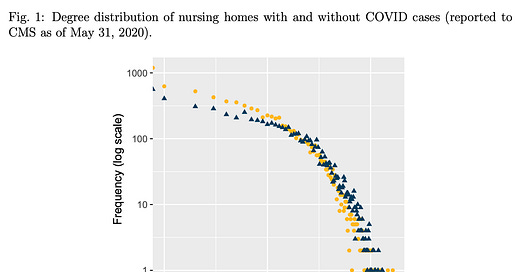Together by a tether
New research suggests nursing home outbreaks can be reduced by 44% with better employment policies to generate Covid-19 bubbles
Welcome to Plugging the Gap (my email newsletter mainly about Covid-19 and its economics). My goal is for several posts a week explaining economic research and the economic approach to understanding the pandemic. I may also deviate to other topics as well. (In case you don’t know me, I’m an economist and professor at the University of Toronto. I have written lots of books including most recently on Covid-19. You can follow me on twitter (@joshgans) or subscribe to this email newsletter at the link below).
In yesterday’s post, I emphasised the importance of network structure — that is, how links between groups are altered by different reopening policies and how, for different cities, that can imply very different trade-offs between the economy and health in terms of which bundle of activities you want to prioritise.
Today, the focus is on nursing homes where the fatal consequences of Covid-19 have been most deeply felt in so many places. I will highlight new research that showed how an appreciation of network structure could have — and could continue to — avoid many deaths there.
Economists Keith Chen and Judy Chevalier and, medical researcher, Elisa Long explored the patterns of movements in and out of nursing homes across several states of the US. Their paper is here. They collected data from smartphones to determine where people who visited nursing homes also went. The answer: from a sample of 30 million phones, 7% of those who visited one nursing home also visited another. And that 7% was observed after the restrictions in March that limited visits to those homes.
Why is this significant? Covid-19 spreads through contacts — most likely by people who are breathing the same air for a certain period of time indoors. The indoors is already a clue as to why prevalence in nursing homes might be high. The related fatality rate is because residents of nursing homes are particularly vulnerable to complications from Covid-19.
The paper finds that these connections and their numbers strongly predict Covid-19 outbreaks in nursing homes. What is going on is that there is travel between homes by employees. Nurses have a median salary that amounts to $28,000 from one job so it isn’t surprising that they may take on shifts elsewhere to make ends meet.
There are two network measures that are important. The first is degree which is the number of nursing homes with a link to another nursing home. The second is strength which is a weighted average of these connections to take into account the number of smartphones that have traversed a given link. Connectedness is quite varied as you can see from the following figure:

What this means is that across different states there can be very different network patterns. Moreover, as you can see, the ones with lower connections have on average fewer Covid infections.
But let’s delve into the network structure.

You can see how these can make studying this stuff difficult. In State A, you can see a blue dot that doesn’t have many connections (either low-intensity blue or high intensity green or yellow). But it is connected to another nursing home that has lots of connections. They are drawn together by just a tether. This means that it is more connected than say the blue dot in State E.
It is hard to grasp what the effects might be from these graphs so the paper delves into the statistics. However you cut it, increased network connectedness increases Covid cases. 10 more neighbours with at least one connection - a 26% rise in cases. 10 more contacts within a connection - another 12.1% rise. Weight these and you get 30.7% and move from the state with the fewest connections to the most connected and there are 190% more cases.
This finding comports with research on Europe and US states that showed that countries/states, where long-term care beds per capita (controlling for demography) were lower, had much lower fatality rates.
The action item is clear: nursing homes have to create staff bubbles to stop these inter-home connections. Do this and you can potentially reduce infections by 44 per cent.
Here is a convenient video summary of the paper from one of the authors.
Want to read more about network connections and contagion? I recommend Matthew Jackson’s The Human Network as a great introduction for the average reader.
What did I miss?
August: Cities and Covid Reopening
July: That DisneyWorld Reopening: An Opportunity Lost?
July: Will a Covid-19 vaccine exacerbate the economic downturn?



